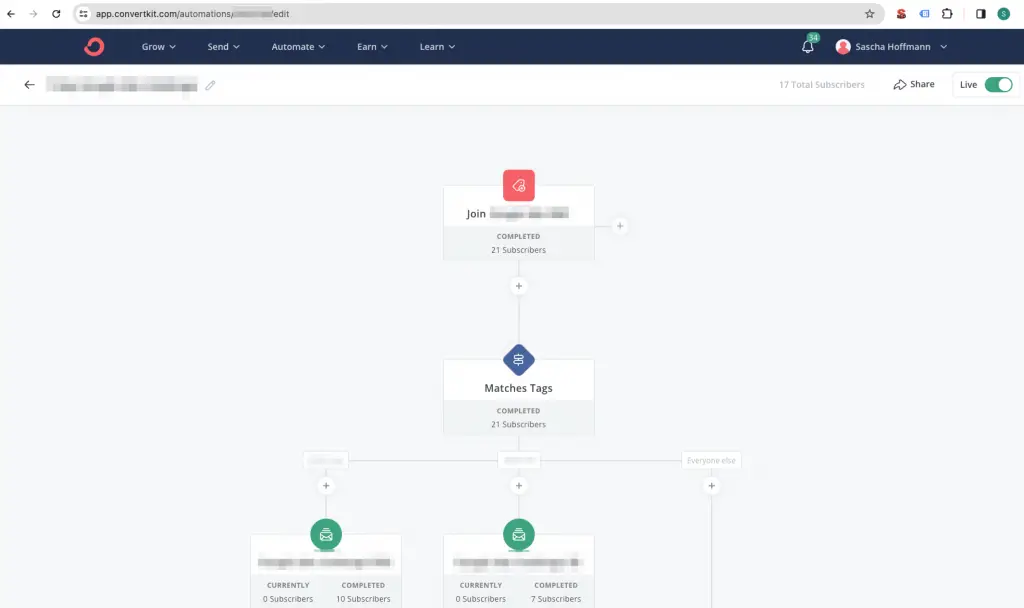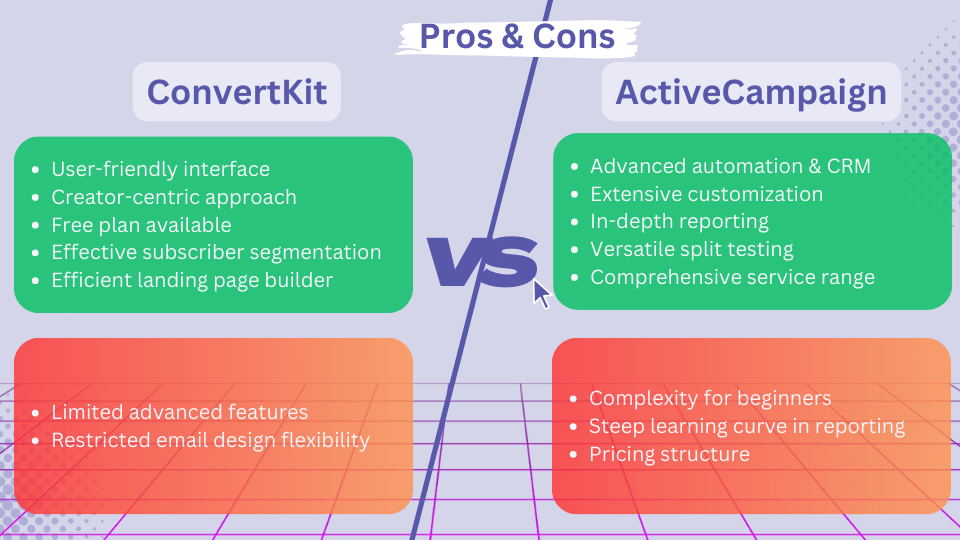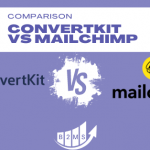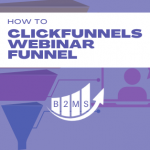ConvertKit vs ActiveCampaign: Which Is Best for You?
Choosing between ConvertKit and ActiveCampaign can be tricky. Both are robust email automation tools that provide tons of options to optimize your marketing funnel.
It’s difficult for a non-expert to spot significant differences between the two. Nonetheless, there are many distinctions every user needs to be aware of to choose the ideal tool for them.
It’s crucial to select the right platform because once you select and implement one, it’s very sticky and becomes hard to switch!

In this ConvertKit vs. ActiveCampaign guide, we’ll highlight the core differences between the two platforms. We’ll also help you pick the one that suits your business needs perfectly.
Heads-up: I went personally through the valuation and used ConvertKit for my email marketing.
Conclusion Pre-Take
ConvertKit: Best for Creators and Small Businesses
ConvertKit is ideally suited for individual creators, bloggers, and small businesses. Its user-friendly interface and straightforward email automation tools make it a perfect choice for those who are new to email marketing or prefer simplicity.
ConvertKit’s focus on essential features without overwhelming users with complexity makes it the go-to option for content creators who need to manage their email lists effectively without requiring extensive marketing knowledge.
ActiveCampaign: Best for Advanced Marketers and Growing Businesses
ActiveCampaign stands out as the better choice for advanced marketers and businesses with more complex needs. Its robust automation capabilities, detailed reporting, and CRM integration cater to those who seek depth in their marketing strategies.
If your business requires intricate automation sequences, detailed analytics, and a high degree of customization, ActiveCampaign offers the comprehensive toolkit necessary to scale and refine your marketing efforts.
ConvertKit and ActiveCampaign: An Overview
Here’s a quick look at the two popular platforms:
ConvertKit
ConvertKit is one of the most popular email automation service providers.
It’s a cloud-based lead nurture software that equips creators with tools to collect, nurture, and convert their email list subscribers.
It offers newsletters, email sequences, and other options for users.
The company was established in 2015. ConvertKit claims that over 500 thousand creators use their services to reach their audience today.
ActiveCampaign
ActiveCampaign is a customer experience automation platform. It offers email marketing services and plenty of other options to help you with lead scoring, analytics, and CRM management.
The tool also provides a lot of integration choices to boost your overall marketing automation.
The company was founded in 2003. Today, it has a customer base of over 180,000 clients across 170 countries.
ConvertKit and ActiveCampaign Comparison: A Quick Look
Here’s a quick comparison of the two tools’ features:
| Feature | ConvertKit | ActiveCampaign |
| Ease of Use | 9/10 | 7/10 |
| Editor’s Options and Interface | 5/10 | 7/10 |
| Email Automation Options | 6/10 | 8/10 |
| Templates and Customization | 7/10 | 8/10 |
| Landing Pages and Registration Forms | 5/10 | 7/10 |
| Reporting and Analytics | 6/10 | 7/10 |
| Integrations | 7/10 | 9/10 |
| Split Testing | 6/10 | 8/10 |
| Spam Testing | No | Yes |
| Tags System and List Management | 8/10 | 8/10 |
| Deliverability Rate | 8.5/10 | 9/10 |
| Support Service | 9/10 | 9/10 |
ConvertKit and ActiveCampaign: What Are the Similarities?
Although the tools have multiple differences, they also share a few similarities. Here are the common features of the two platforms:
- Lead capture and email automation are the bread-and-butter for both platforms.
- High deliverability rate: ConvertKit has a deliverability rate of 88.2%, while ActiveCampaign’s rate is 91.7%.
- Top-notch support service: You can expect a quick response when contacting either platform’s support services via live chat or email.
- Reliable tags system and email list management options: Both platforms offer accurate targeting options based on various subscribers’ characteristics.
ConvertKit vs. ActiveCampaign: Detailed Features Comparison
Here’s an in-depth comparison between ConvertKit and ActiveCampaign features:

Ease of Use
ConvertKit has relatively fewer options compared to ActiveCampaign. This makes ConvertKit much easier to deal with for first-time automation tool users.
However, experienced email automation users may not consider simplicity an advantage. They won’t have any problem understanding and using ActiveCampaign’s advanced features.
Overall, ConvertKit takes less time to learn and master. Still, ActiveCampaign isn’t overly complicated or overwhelming. It only takes time to get used to its plentiful options.
The Winner: ConvertKit
ConvertKit is straightforward to use, even if you’re using automation tools for the first time.
Editor’s Options and Interface
ConvertKit’s editor is simple and easy to use but lacks interactivity. It also provides limited formatting options and visuals.
For this reason, it may be challenging to create highly customized emails using ConvertKit unless you apply a bit of HTML code.
Conversely, ActiveCampaign has an interactive drag-and-drop editor with endless options.
The vast number of commands in ActiveCampaign can be overwhelming at first. Though, you can hover over any of them to get instructions on how to use them.
More interestingly, in ActiveCampaign, you can save command blocks and use them later. This saves you tons of time.
That said, the downside of ActiveCampaign is that the undo button can go back multiple steps. So, if you use the undo button, you’ll have to redo a few tasks again.
The Winner: ActiveCampaign
ActiveCampaign’s editor is more interactive and offers considerably more customization options.
Email Automation
ConvertKit allows you to target each audience segment with personalized email campaigns precisely.
It also offers you many integration options, so you can use automated emails with WordPress or a few other platforms.
Use the if/then rules to identify many triggers and associated activities. The best thing is that the if/then rules are straightforward to use.
On the other hand, ActiveCampaign email automation options are plentiful and cover more triggers and actions than that of ConvertKit.
You can use ActiveCampaigns to optimize your marketing funnel beyond lead nurturing emails. Use it to set up abandoned cart notifications, follow-up and discount emails, and many more.
The Winner: ActiveCampaign
ActiveCampaign provides considerably more triggers and actions you can use in your automation.
Email Templates and Customization
ConvertKit provides a limited selection of email templates for your email campaigns. It also offers only a few visual options to include in your emails.
So, you have only a little room for creativity in crafting your campaigns. That said, you can use your HTML knowledge to design your customized template or modify a current one.
Still, this option isn’t beginner-friendly, as people with little to no tech knowledge won’t be able to use it.
Conversely, ActiveCampaign provides over 150 email templates—all of which are responsive and highly customizable.
That way, you can tailor them to your brand much more easily compared to ConvertKit.
More interestingly, all ActiveCampaign plans give you access to their customized email design service. You can even request a designer to create your email template for free.
The Winner: ActiveCampaign
Unlike ConvertKit, ActiveCampaign can provide you with a wide array of templates to choose from when designing your emails.
Landing Pages and Registration Forms
Both ConvertKit and ActiveCampaign offer the option to build custom landing pages for lead capture or sales. They provide a variety of templates to use for these purposes.
Likewise, the two platforms allow you to create one of four types of registration forms.
The difference is that ConverKit gives you ready-to-use templates for each form type, with little room for customization.
On the other hand, ActiveCampaign allows you to design the whole form from scratch if you want.
So, ConvertKit forms are easy to craft but lack customization. ActiveCampaign’s forms are highly customizable and can be significantly edited to reflect your brand identity. Still, it’ll take more time to set up.
The Winner: ActiveCampaign
ActiveCampaign offers you a range of customization options for creating registration forms.

Reporting and Analytics
ConvertKit’s reports and analytics are basic. The platform offers only limited data about your email campaigns’ performance.
This includes open rates, click-through rates, unsubscribe rates, and a few other data. Most experienced marketers expect more from an email automation system.
ActiveCampaign will provide you with the data ConvertKit delivers and many more additional helpful insights.
Depending on the type of integration you use with your email campaigns, you can get a detailed report on the overall performance.
You’ll be able to track your users’ geographic locations, visited pages and click maps, to name a few.
In addition, if you link your active campaign to your Shopify or any E-Commerce store, you’ll get additional website performance, sales, and revenue data.
The Winner: ActiveCampaign
ActiveCampaign goes beyond the basic email performance data. It includes in-depth information about the overall marketing insights.
Integrations
ConvertKit provides integration with well-known tools like Shopify, Zapier, Squarespace, OptinMonster, WordPress, and others.
This can be perfect for a company with small-scale workflows. Nonetheless, for large business systems, ConvertKit integration options might not be sufficient.
On the other hand, ActiveCampaign offers tens of possible integrations with a wide variety of tools. This includes the tools ConvertKit integrates with and dozens of other alternatives.
For this reason, ActiveCampaign is an excellent option for businesses with a larger-scale lead nurturing workflow or automation system.
The Winner: ActiveCampaign
ActiveCampaign gives you dozens of integrations with plenty of online tools.
A/B Testing
Both ConvertKit and ActiveCampaign offer built-in A/B testing.
ConvertKit offers you the option to test only the email subject line. If you want to assess other variables, you’ll do it manually or resort to other tools.
On the other hand, ActiveCampaign split testing allows you to evaluate various variables. This can be the subject line, visuals, CTA, etc.
That way, you can optimize email campaigns without the hassle of using multiple tools.
So, if your business depends on complex email sequences requiring extensive testing, ActiveCampaign can be your ideal option. However, if your email sequence is basic, ConvertKit may be just enough.
The Winner: ActiveCampaign
ActiveCampaign allows you to test multiple email variables without using external tools.

ConvertKit vs. ActiveCampaign: Price Comparison
ConvertKit and ActiveCampaign follow a subscriber-based pricing model. In other words, you pay for the number of subscribers in your newsletter.
Nonetheless, there are some differences in the plans of each tool. Let’s take a look:
| Plan | ConvertKit | ActiveCampaign |
| Free Plan | Up to 1000 Subscribers | No Free Plan |
| 1000 Subscribers | Starts at $25 per month | Starts at $29 a Month |
| 5000 Subscribers | Starts at $66 a Month | Starts at $79 a Month |
| 10,000 Subscribers | Starts at $100 a Month | Starts at $139 a Month |
Comparing the pricing plans, you’ll notice that ActiveCampaign charges considerably more than ConvertKit.
Still, if you use the advanced options in ActiveCampaign, you’ll get a higher value for your extra dollars. That way, which tool is better in pricing depends mainly on your needs.
ConvertKit vs. ActiveCampaign: Pros and Cons

ConvertKit Pros:
- User-Friendly Interface: Ideal for beginners and non-marketers, ConvertKit offers a straightforward and intuitive user experience.
- Creator-Centric Approach: Specifically tailored for bloggers and creators, making it a great fit for content-driven email strategies.
- Free Plan Availability: Offers a competent free plan for up to 1000 subscribers, suitable for small businesses and startups.
- Effective Subscriber Segmentation: Features a powerful tag system for efficient and precise subscriber segmentation.
- Efficient Landing Page Builder: Provides reliable and easy-to-use tools for creating effective landing pages.
ConvertKit Cons:
- Limited Advanced Features: Lacks some of the more sophisticated capabilities available in other platforms, which might be a drawback for advanced users.
- Restricted Email Design Flexibility: Offers basic email-building options with limited customization, which might not suffice for highly stylized email campaigns.
ActiveCampaign Pros:
- Advanced Automation and CRM: Renowned for its comprehensive automation capabilities and robust CRM features, catering well to complex marketing strategies.
- Extensive Customization: Offers a wide array of highly customizable email templates and registration forms.
- In-Depth Reporting: Provides detailed and rich-in-data reports, offering valuable insights for data-driven marketing.
- Versatile Split Testing: Multiple split testing options allow for thorough optimization of email campaigns.
- Comprehensive Service Range: Beyond email automation, it offers a variety of complementary services, enhancing overall marketing efforts.
ActiveCampaign Cons:
- Complexity for Beginners: The platform’s wide array of features can be overwhelming for first-time users or those with basic needs.
- Steep Learning Curve in Reporting: While reporting is comprehensive, it might require a learning curve for beginners to fully utilize.
- Pricing Structure: As the subscriber count increases, the pricing can become a bit steep, which might be a consideration for growing businesses.
Conclusion: ConvertKit vs. ActiveCampaign
If you’re just starting your email automation journey, ConvertKit would be your perfect go-to option. It’s easy to master and requires no prior marketing knowledge.
In addition, ConvertKit can be the ideal choice for a small business with a small-scale automation system.
On the other hand, if you’re an experienced marketer or a business with a large-scale system, ActiveCampaign’s advanced automation options will be more valuable.
Its built-in CRM and various integrations can help optimize your workflow and boost overall marketing performance.

Sascha is a Lifecycle Marketing Consultant with over 8 years of digital marketing experiences in Silicon Valley, the UK, and Germany.
After leading the demand generation for a 100+ million company, he decided to venture out on himself. He’s now helping clients to attract and convert more leads and customers.
His main focus are SEO, paid media & marketing automation – all with the focus to tie marketing campaigns to revenue.
Sascha has been featured in industry publications.



